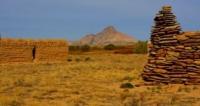Вы здесь
Ancient settlement Taldysai.

Best Kazakhstan Tours 2025.
“This ancient metallurgical settlement was found quite by accident. Every spring, rivers filled with water from melted snow overflow their banks. As a result, new riverbeds were formed, which eroded the coastal lands, exposing the eastern zones of the ancient settlement. Ceramic products and stone fences of the dwelling belonging to the metallurgical settlement Taldysai came to the surface. Since then, Taldysai has become the main object of research for the archaeological expedition of Central Kazakhstan.”
Researcher at the Museum of Mining and Smelting of the town of Zhezdy M. Birimzhan.
Steppe and Mountain Ulytau Kazakhstan.
The settlement of Taldysay of the ancient metallurgists of the late Bronze Age is located at an altitude of 476 meters above sea level, located 69 kilometers northwest of the city of Zhezkazgan, between the mountains along the line from southeast to northwest of Keregetas and Araltobe, in the eastern part of the small village of Taldysay, 17.4 kilometers northwest of the village of Zhezdy, 509 meters north of the Baskamyr settlement, 115 meters from the confluence of the Ulken Zhezdy and the left tributary of the Ulken Zhezdy - Bala Zhezdy, 380 meters east of the Zhezdy Ulytau highway, in the Ulytau region of the eponymous region.
The settlement was discovered in the early 1990s during a strong spring flood of the Ulken Zhezdy and Bala Zhezdy rivers, which laid a new channel through the southern half of the settlement. After the decline of high water in the channel and coastal cliffs, cultural deposits and remains of stone structures were exposed. Since that time, the settlement has been intensively destroyed by the river.
The settlement of Taldyssay in the Bronze Age was one of the points for processing Zhezkazgan ores. Since 1992, it has been explored by the Central Kazakhstan Archaeological Expedition. During 2004 - 2006 the monument was studied in the framework of the state program "Cultural Heritage".
The settlement is investigated by three excavations. The most significant area is Excavation 1. Conventionally, it was divided into two sections - western and eastern, within which there are two residential industrial complexes.
In the western housing industrial complex, a pit was found on the eastern, western, and northern sides of the dwelling half of the earth type. The northern wall of the pit had a stepped shape. The western complex basically had a metallurgical pit, furnace No. 2, a type mine and a well with it, adjoining production areas with a foci system and a ground type pit, as well as holes, pits and grooves around them.
Within the eastern section, the eastern housing production complex, which is associated with metallurgical production, is being investigated.
The side of the dwelling of the workshop of the western and northwestern sides and two heating grooves (chimneys) were revealed. In the dwelling of the workshop, 4 metallurgical pits were identified, of which the three investigated were of a mine type and had adjacent ground systems.
After dwelling in the workshop’s dwelling, mass sacrifices of animals, and possibly people, were made. Within a radius of 3-5 kilometers from the settlement of Taldyssay, more than 10 monuments of different eras have been discovered.
Archaeologists call them the "miracles of Taldyssai": four sites of the Mesolithic and Neolithic era, a settlement of the Eneolithic and the cave of Bala Zhezdy, a settlement and burial grounds of the Bronze Age and Turks of the Kipchak era, Saki mounds, the remains of irrigation systems, the medieval settlement of Baskamyr, a watchtower and a hilltop at the top of the hill Kazakh cemetery of the XVII - XIX centuries.
The existence on the territory of the Ulytau-Zhezgazgan region - one of the largest metallurgical centers of the ancient world - has special scientific value.
The technique of manufacturing copper and bronze products is closely connected with the sacred world of man and is riddled with mythical symbols. Of undoubted interest is the ratio of the two principles in metallurgical production - sacred and utilitarian.
A cave was discovered west of the Bronze Age settlement. She served as a home for people at different times. Now the main excavations are conducted at the settlement of Taldyssay and the eponymous burial ground of the Bronze Age, in the parking of the Stone Age Toktauul.
Over 20 years of stationary work, dwellings, production workshops, smelting furnaces, tools, animal bones and much more were found. The settlement was one of the metallurgy centers of the Ulytau-Zhezkazgan region in the second half of the second century. BC e. - in the first half of the Ist century BC e.
And the inhabitants used copper as a commodity for exchange with the tribes of Central Asia, South and Western Siberia.
Geographical coordinates of Taldysay settlement: N48°12'51.11" E67°01'16.52"
Authority:
"Archaeological map of Kazakhstan." Alma-Ata, 1960. No. 937, table III, 16.21. Akishev K.A. "Antiquities of Northern Kazakhstan." “Proceedings of the Institute of History, Archeology and Ethnography” T.7. Archeology. Alma-Ata, 1959. p. 9, fig. 4-5, tab. I. Margulan A.Kh. "The remains of settled settlements in Central Kazakhstan." "Medieval hillforts and settlements." Zhezkazgan, 1996.111 s. www. tengrifund.ru
Photos by
Alexander Petrov.







